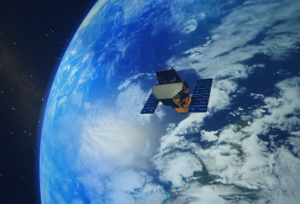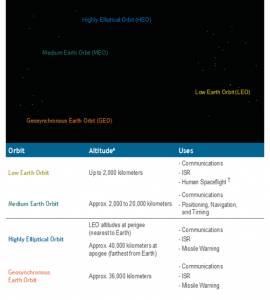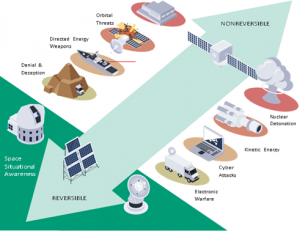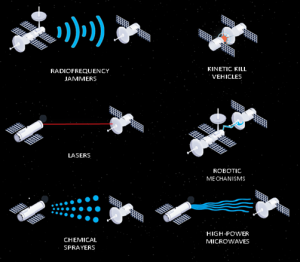14 Satellite Killers
By Dr. Mark Jackson
Student Learning Objectives
The student will be able to:
- Understand what a satellite is and how they are classified;
- Understand how satellites orbit and why they overlap in terms of orbital position;
- Understand the concept of denying space and satellite killers;
- Define the differences between directed energy weapons, ground-based killer missiles, and space-based weapon systems.
Satellites
Introduction
An artificial satellite is a stationary or rotating object intentionally put into orbit around Earth. The first artificial satellite was launched in 1957, and since that time, around 9,000 from 40+ countries have been launched into orbit. Currently, there are approximately 5,000 remaining in orbit where 2,000 are operational, and the rest are considered space debris. Two-thirds of the operational satellites are in low-Earth orbit, while the remaining third are in medium-Earth, geostationary and elliptical orbits (Figure 14.1).
Figure 14.1. A satellite in Low Earth Orbit (LEO) around Earth

Source: (U.S. Naval Academy, Colorado Springs, March 2022)
Space stations have been launched and assembled in orbit, while spacecraft have been placed in orbit around Earth’s moon, Venus, Mars, Jupiter, Saturn, Mercury asteroids, comets, and the Sun. Satellites are used to map surfaces of planets and maps of distant stars and are military and civilian Earth-observing satellites. Some satellites are used for communication and navigation; they map weather patterns and are used as telescopes for deep space purposes. Constellations of satellites can also overlap orbits for many different purposes, such as weather tracking and communications.
Satellites ate normally launched from a rocket from land, sea by submarine or mobile launch platforms, or launched from the air by aircraft. Sub-systems usually perform many different tasks that aid the satellite as it is launched and in orbit. The subsystems provide power, control temperature, control position and attitude, communicate and provide scientific data using sensors.
Classification of Satellites
Satellites are classified in terms of their purpose and are classified as follows:
Astronomical satellites – observation of distant planets and galaxies;
Biosatellites – carry living organisms to aid scientific experiments;
Communication satellites – communications satellites use geosynchronous or Low Earth orbits to communicate with each other and other systems;
Earth observation satellites are satellites intended for non-military uses such as environmental monitoring, meteorology, and producing maps;
Killer satellites are designed to destroy warheads, satellites, and space-based objects;
Navigational satellites use radio time signals transmitted to enable mobile receivers on the ground to determine their exact location. The relatively clear line of sight between the satellites and receivers on the ground allows satellite navigation systems to measure location to accuracies on the order of a few meters in real-time;
Reconnaissance satellites are communications satellites deployed for military or intelligence applications;
Recovery satellites provide a recovery of reconnaissance, biological, space-production, and other payloads from orbit to Earth;
Space stations are orbital structures designed for human beings to live in space. A space station is distinguished from other crewed spacecraft by its lack of major propulsion or landing facilities. Space stations are designed for medium-term living in orbit;
Tether satellites are connected to another satellite by a thin cable called a tether; and
Weather satellites are used to monitor Earth’s weather and climate.
Satellite Orbits
The most common type of orbit is a geocentric orbit, with over 3,000 active artificial satellites orbiting the Earth. Geocentric orbits may be further classified by their altitude, inclination, and eccentricity.
The commonly used altitude classifications of the geocentric orbit are Low Earth Orbit (LEO), Medium Earth Orbit (MEO), Geosynchronous Orbit (GEO), and High Earth Orbit (HEO). Low Earth Orbit is any orbit below 2,000 km, Medium Earth Orbit is any orbit between 2,000 and 36,000 km, and High Earth Orbit is greater than 36,000 km (Figure 14.2).
Centric classifications
A galactocentric orbit is an orbit around the center of a galaxy.
A heliocentric orbit is an orbit around the Sun. In our Solar System, all planets, comets, and asteroids are in such orbits, as are many artificial satellites and pieces of space debris.
Geocentric orbit is an orbit around Earth, such as the Moon or artificial satellites. Currently, there are over 2,500 active artificial satellites orbiting the Earth.
Altitude classifications
Low Earth Orbit (LEO): Geocentric orbits ranging in altitude from 180 km – to 2,000 km;
Medium Earth Orbit (MEO): Geocentric orbits ranging in altitude from 2,000 km – to 20,000 km;
Geosynchronous Orbit (GEO): Geocentric circular orbit with an altitude of 36,000 km. The orbit period equals one sidereal day, which coincides with the Earth’s rotation period. The speed is 3,075 m/s (10,090 ft/s).
High Earth orbit (HEO): Geocentric orbits above the altitude of a geosynchronous orbit (GEO) > 36,000 km (~ 40,000 km).
Figure 14.2. Classification of altitude orbits and uses

Source: ((Challenges to Security in Space, Defense Intelligence Agency, 2022 (www.dia.mil)))
Inclination classifications
Inclined orbits are those whose inclination about the equatorial plane is not zero degrees;
Polar orbits pass above or nearly above both poles of the planet on each revolution. It has an inclination of ~ 90 degrees; and
Polar sun-synchronous orbits are polar orbits that have nodal precessions such that a satellite in orbit passes the equator at the same local time on every pass.
Eccentricity classifications
Circular orbits have an eccentricity of 0 degrees, and their path traces a circle;
Using two engine impulses, Hohmann transfer orbits move spacecraft from one circular orbit to another. The perihelion of the transfer orbit is at the same distance from the Sun as the radius of one planet’s orbit, and the aphelion is at the other. The two rocket burns change the path from one circular orbit to the transfer orbit and later to the new circular orbit;
Elliptic orbits have eccentricities greater than > 0 and < 1, whose orbit traces the path of an ellipse;
Geosynchronous transfer orbits are elliptic orbits where the perigee is at the altitude of a Low Earth Orbit (LEO) and the apogee at the altitude of a geosynchronous orbit. Satellites use this orbit to transfer to a geostationary orbit;
A geostationary transfer orbit is a transfer orbit that is used to transfer to a geostationary orbit;
Molniya orbit is a highly eccentric orbit with an inclination of 63.4° and an orbital period of half of a sidereal day (~ 12 hours). Such a satellite spends most of its time over two designated areas of the planet (Russia and America); and
Tundra orbit is a highly eccentric orbit with an inclination of 63.4° and an orbital period of one sidereal day (~ 24 hours). Such satellites spend most of their time over a single designated area of the planet.
Synchronous classifications
Synchronous orbits where the satellite has an orbital period equal to the average rotational period of the body being orbited and in the same direction of rotation as that body. The satellite would trace an analemma in the sky;
Semi-synchronous orbits (SSO) with an altitude of approximately 20,200 km (12,600 miles) and an orbital period equal to one-half of the average rotational period of the body being orbited;
Geosynchronous orbits (GSO) with an altitude of approximately 35,786 km (22,236 miles);
Geostationary orbits (GEO) with an inclination of zero;
Disposal orbits are a few hundred kilometers above geosynchronous that satellites are moved into at the end of their operation;
Areosynchronous orbits around Mars with an orbital period equal in length to Mars’ sidereal day, 24.6229 hours; and
Heliosynchronous orbit is a heliocentric orbit about the Sun where the satellite’s orbital period matches the Sun’s period of rotation.
Satellite Killers
Introduction
Since 2019 the space fleets of China and Russia have grown by 70 % and continue to contribute to the congestion of the orbits. The continued expansion follows a period of growth since 2015 where China and Russia had increased their satellites numbers by 200 % in areas such as satellite communications (SATCOM) ~ 148 satellites, remote sensing ~ 294 satellites, navigation-related satellites ~ 77 satellites, and science and technology satellites ~ 143 satellites (Figure 14.3).
Figure 14.3. Number of Russian (left) and Chinese (right) satellites in orbit between 2019 and 2021

Source: (Union of Concerned Scientists – Satellite Database (1/1/2022) (www.dia.mil))
As space and counter-space capabilities increase, China and Russia integrate space scenarios into their military exercises. They continue to develop anti-satellite (ASAT) weapons, or killer satellites, that threaten the U.S. and allied space assets. China and Russia are pursuing ‘non-weaponization of space’ agreements at the U. N. to curb the strength of the U. S. The expansion of Chinese and Russian space weapons is changing the way nations formulate and formalize their space capabilities. This may lead to the denial of space for many different reasons.
Denying space
Space is critical for U.S. and allied military forces during operations, exercises, and logistics, providing for instantaneous communications, situation awareness, and precision navigation for the military. Military and civilian space services are not easily distinguished. Counterspace weapons are intended to degrade space capability others kill satellites permanently. The following conditions can occur (Figure 14.4):
- Physical or cyber-attacks against ground sites and infrastructure supporting space operations can threaten satellites;
- Space awareness sensors predict when satellites pass overhead allowing for the tracking, warnings, and targeting of space systems;
- Global navigation and communications satellites can be jammed by enemies that are used for naval, ground, and air forces as well as manned and unmanned vehicles;
- Adversaries that target satellites can blind imagery satellites and other strategic sensors, denying the ability to monitor, track, and target forces.
Figure 14.4. The counter-space continuum shows the range of threats to space-based satellite services. Reversible effects include temporarily affecting space services, while irreversible effects include direct energy weapons, orbital threats, and nuclear detonations that permanently kill satellites services.

Source: (DIA, 2022).
- Killer missiles can be used to kill satellites in LEO and produce debris that can remain in orbit for decades or even centuries. China tested a killer missile against its defunct weather satellite in 2007 that created a debris cloud posing a threat to satellites in close orbits. Russia also used a killer missile in December 2021 to destroy one of its satellites.
Other space-based weapons can kill satellites. Countries with nuclear weapons can launch a warhead on a long-range booster ICBM and conduct a high-altitude nuclear detonation, which would create widespread electromagnetic disruptions in space and on Earth, leading to killing or severely disrupting satellites.
Satellite Killers: China
China destroyed one of its weather satellites more than 800 kilometers above the Earth with a satellite-killing missile in 2007. This destructive test generated more than 3,000 pieces of trackable space debris, of which more than 2,700 remain in orbit, and most will continue orbiting the Earth for decades (Figure 14.5). China’s military units have continued training with satellite killing missiles.
China intends to develop more killer satellite weapons to destroy satellites up to GEO. In 2013, China launched an object into space on a ballistic trajectory with a peak orbital radius above 30,000 kilometers to GEO altitudes suggesting that a basic capability could exist to use satellite killers at great distances beyond LEO. China is also developing other space-based capabilities such as satellite inspection and repair. China has launched multiple satellites to conduct scientific experiments on space maintenance and is conducting research on space debris cleaning. In January 2022, Shijian-21 moved a navigation satellite to a high graveyard orbit above GEO. Space-based robotic arm technologies may be used in a future system for capturing space debris.
Since 2006, universities in China began investigating aerospace engineering aspects associated with space-based kinetic weapons used to kill satellites and other space-based assets. Space-based kinetic weapons research includes re-entry methods, separation of pay-load, delivery vehicles, and transfer orbits for targeting purposes. China also conducted the first fractional orbital launch of an ICBM with a hypersonic glide vehicle in July 2021. This demonstrated the greatest distance flew (~40,000 kilometers) and the longest flight time (~100+ minutes) recorded for a hypersonic glide vehicle.
Figure 14.5. Computer simulation of tracked objects in Earth’s orbit. Red, yellow, and green objects are representations of active satellites and debris in the GEO and MEO.

Source: (DIA, 2022)
Satellite Killers: Russia
Russia is developing a mobile missile defense complex capable of destroying ballistic missiles and low-orbiting satellites. The weapon system created over 1,500 pieces of trackable space debris and tens of thousands of pieces of lethal debris in November 2021. The debris endangers spacecraft in LEO, including astronauts and cosmonauts on the ISS and China’s Tiangong space station. Russia demonstrated the capability of the missile to destroy satellites in LEO and is developing an air-launched killer weapon targeting spacecraft in LEO. Further orbital threats include a killer weapon developed by Russia that targets foreign satellites but protects Russian satellites. The same technology can inspect and diagnose satellites’ technical conditions before repairing or killing them.
In 2019, Russia launched two satellites, with one following a U.S. national security satellite. In July 2020, Russia launched an object into orbit near a similar Russian satellite to test a space-based killer weapon. Cosmos 2504 and Cosmos 2536 are prototype Russian killer weapons that can kill satellites in LEO.
Space Awareness and Space-Based Weapons
Directed energy weapons are designed to produce reversible or non-reversible effects against space systems to disrupt, damage, or destroy enemy equipment and facilities. Directed energy weapons include lasers, high-power microwaves, and radiofrequency weapons. Reversible effects include temporarily blinding optical sensors to deny imagery of targeted military forces. Non-reversible effects include permanently damaging or destroying sensors or other satellite components.
Killer missiles are designed to destroy satellites without being in orbit. The weapons typically consist of a fixed- or mobile-launch system, a missile, and the kinetic kill vehicle. The weapons may also be launched from aircraft, ships, and submarines. The kinetic kill vehicle uses a seeker to intercept the satellite. Ground-based create orbital debris and can easily be detected (Figure 14.6).
Figure 14.6. Space-based weapons

Source: (DIA, 2022)
Space-based weapons are satellites that can attack other spacecraft, thus making spacecraft sitting targets. They include radiofrequency jammers, kinetic kill vehicles, lasers, chemical sprayers, and high-power microwave weapons.
Questions
- What is a satellite?
- Describe the orbits of satellites and the type of orbit required for communication satellites?
- What are the altitude and centric classifications of satellites?
- What is a satellite killer, and why deny space to a particular nation?
- Explain why Russia and China need to kill satellites and how they achieve this?
- What is space debris, and why is it so damaging to other satellites?
- What are the implications of space awareness?
- Describe the multitude of space-based weapons.
Bibliography
(n.d.).(Challenges to Security in Space, Defense Intelligence Agency, 2022 (www.dia.mil)).
American Bureau of Shipping. (2019). ABS Rules for Building and Classifying Underwater Vehicles, Systems and Hyperbaric Facilities. Houston, Texas: American Bureau of Shipping.
Button, R. W. (2009). A Survey of Missions for Unmanned Undersea Vehicles. Santa Monica, California, USA: RAND Corporation.
Department of Defense. (2011). Unmanned Systems Integration Roadmap: 2011 – 2036. Washington DC, USA: US Government.
Department of Defense. (2012). Sustaining US Global Leadership: Priorities for the 21st Century Defense. Washington DC, USA: US Government.
Department of the Navy. (2004). The Navy Unmanned Undersea Vehicle Master Plan. Washington DC, USA: US Government.
DIA. (2022). Challenges to Security in Space. Retrieved from www.dia.mil: www.dia.mil
Hughes, O. F. (2010). Ship Structural Analysis and Design. New York, USA: Society of Naval Architects and Marine Engineers.
Lewis, E. V. (1988). Principles of Naval Architecture: Volumes I, II, and III. New York, USA: Society of Naval Architects and Marine Engineers.
MAN Energy Solutions. (2018). Basics of Ship Propulsion. Berlin, Germany: MAN.
Nichols, R. K. (2020). Unmanned Vehicle Systems and Operation on Air, Sea, and Land (Vol. IV). Manhattan: New Prairie Press.
(n.d.).The U.S. Naval Academy, Colorado Springs, March 2022.
(n.d.).Union of Concerned Scientists – Satellite Database (1/1/2022) (www.dia.mil).
US Congress. (2020). Navy Large Unmanned Surface and Undersea Vehicles: Background and Issues for Congress (Report 45757). Washington DC: US Congress.
Informative Readings and Additional Bibliography
Satellite Killing and Denying Space:
Azanov, Roman; 24 December 2019; “‘Armament Is Not a Chess Game.’ What Equipment the Russian Army Received in 2019: TASS on Principal Deliveries of Military Equipment and Arms to the Country’s Armed Forces Arms and Branches According to the Year’s Results”; TASS.
Claus, Malcom; 9 November 2018; “New Russian missile likely to be part of the anti-satellite system”; Jane’s Intelligence Review.
Comprehensive Nuclear Test Ban Treaty Organization; 5 November 2020; “9 July 1962: ‘Starfish Prime,’ Outer Space”; https:// www.ctbto.org/specials/testing-times/9-july-1962starfish-prime- outer-space. Accessed February 17, 2022.
Dickinson, James H., Gen.; 21 April 2021; United States Space Command Presentation to the Subcommittee on Strategic Forces, House Armed Services Committee, U.S. House of Representatives: Fiscal Year 2022 Priorities and Posture of the United States Space Command, p. 6; https://docs.house.gov/meetings/ AS/AS29/20210421/112467/HHRG-117-AS29-Wstate-DickinsonJ-20210421.pdf. It was accessed on March 12, 2022.
Gazeta; 28 July 2018; “In Russia, new strategic weapons are being created.”
Gundarova, Lyudmila; 27 May 2021; “Star/Junk Wars: How to Blind the Enemy and Not Blind Yourself”; Nezavisimoye Voyennoye Obozreniye; https://nvo.ng.ru.
Hendrickx, Bart; 27 September 2018; “Russia Develops Co-Orbital Anti-Satellite Capability”; Jane’s Intelligence Review.
Hennigan, W.J.; 23 July 2020; “America Really Does Have a Space Force. We Went Inside to See What It Does”; Time; https:// time.com/5869987/spaceforce/.
Izvestiya; 28 May 2019; “An Expert Has Spotted the Russian VKS’s New Missile Interceptor.”
Jones, Andrew; 29 October 2021; “China launches classified space debris mitigation technology satellite”; Space News; https:// spacenews.com/china-launches-classified-space-debris-mitigation-technology-satellite/. It was accessed on March 15, 2022.
Khodarenok, Mikhail; 19 June 2020; “Russia: Defense Industry Source Provides Delivery Schedule for S-500 Prometey, Nudol Systems”; Gazeta; https://www.gazeta.ru/ army/2020/06/19/13123189.shtml.
Milkavkaz.net; 23 December 2015; “Russia: Aerospace Forces Order of Battle.”
Mizokami, Kyle; 1 October 2018; “Russia’s MiG-31 Spotted with Possible Anti-Satellite Missile”; Popular Mechanics; https://www.popularmechanics.com/military/weapons/a23549729/rus- sias-mig-31-spotted-with-possible-anti-satellite-missile/.
Mizokami, Kyle; 16 August 2018; “Is Russia’s Mysterious New Satellite a Space Weapon?” Popular Mechanics; https://www.pop- ularmechanics.com/military/weapons/a22739471/is-russias-mysterious-new-satellite-a-space-weapon/.
Nebehay, Stephanie; 14 August 2018; “U.S. Warns on Russia’s new space weapons”; Reuters; https://www.reuters.com/article/us- russia-usa-space-idUSKBN1KZ0T1.
O’Connor, Tom; 12 March 2018; “Russia’s Military has Laser Weapons that Can Take out Enemies in Less than a Second”; Newsweek; http://www.newsweek.com/russia-military-laser-weapons-take-out-enemies-less-second-841091.
Office of the Director of National Intelligence; 11 May 2017; Statement for the Record: Worldwide Threat Assessment of the US Intelligence Community, p. 9.
Office of the Director of National Intelligence; 13 February 2018; Statement for the Record: Worldwide Threat Assessment of the US Intelligence Community, p. 13.
Office of Director of National Intelligence; 11 December 2020; “Support to U.S. Space Command Messaging.”
Office of the Secretary of Defense; April 2015; Annual Report to Congress: Military and Security Developments Involving the People’s Republic of China 2015, p. 14; https://dod.defense.gov/ Portals/1/Documents/pubs/2015_China_Military_Power_Report. pdf. It was accessed on March 8, 2022.
Office of the Secretary of Defense; 1 September 2020; Annual Report to Congress: Military and Security Developments Involving the People’s Republic of China 2020, p. 65; https://media.defense. gov/2020/Sep/01/2002488689/-1/-1/1/2020-DOD-CHINA-MILI- TARY-POWER-REPORT-FINAL.PDF. It was accessed on March 8, 2022.
Poblete, Yleem D.S.; 14 August 2018; “United States Remarks at the Conference on Disarmament as Delivered by Assistant Secretary of State for Arms Control, Verification, and Compliance”; U.S. State Department; https://eneva.usmission.gov/2018/08/14/ remarks-by-assistant-secretary-yleem-d-s-poblete-at-the-conference-on-disarmament/.
Ramm, Alexei; 19 April 2019; “Targeting Stars: What is Known about the New ASAT Weapon? Project NUDOL”; Izvestiya.
Space Control Squadron; “Box Score”; Space-Track.org; https://www.space-track.org/#boxscore. It was accessed on March 15, 2022.
TASS; 6 December 2019; “The Ministry of Defense Conducted an Experiment in Space to Separate a Small Satellite from Another Device.”
- S. Joint Chiefs of Staff; 26 October 2020; Joint Publication 3-14: Space Operations (10 April 2018, Incorporating Change 1), p. I-13.
U.S. Space Command Public Affairs; 15 November 2021; “Russian direct-ascent anti-satellite missile test creates significant, long-lasting space debris”; https://www.spacecom.mil/news/ article-display/article/2842957/russia-direct-ascent-anti-satellite-missile-creates-significant-long-last/#.yzrxfviqul4. Accessed March 14, 2022.
Vyatkin, Yaroslav; 16 April 2015; “Russian Potential for Combating, Acquiring Prompt Global Strike Capability Examined”; Argumenty Nedeli.
Yezhenedelnik Zvezda; 29 September 2020; “Russian Military-Industrial Complex: Debt, Red Tape Impact the Execution of the State Defense Order.”
Zvezda Television; 29 December 2019; “Russia to deploy airborne Peresvet laser.”
Space Awareness and Space-based Weapons:
AP News; 21 September 2020; “German military opens new space operations center”; https://apnews.com/article/national-security-germany-europe-archive-russia-94aaa4939c5c736e268f- 388700b49c6b. Accessed March 5, 2022.
Blenkin, Max; 3 February 2020; “Germany signs up for multi- national Combined Space Operations Initiative”; Space Connect; https://www.spaceconnectonline.com.au/operations/4116-germa- nysigns-up-for-multinational-combined-space-operations-initiative. Accessed March 4, 2022.
Challenges To Security In Space – Space Reliance in an Era of Competition and Expansion, Defense Intelligence Agency, March 2022, p.p. 1 – 70. ISBN 978-0-16-095566-2.
Chuter, Andrew; 15 January 2020; “Former Fighter Pilot Picked to Lead British Military’s Space Command”; Defense News; https:// www.defensenews.com/global/europe/2020/01/15/former-fighter- pilot-picked-to-lead-british-militarys-space-command. They were accessed on March 16, 2022.
DOD News; 5 September 2014; “DoD Agrees to Share Space Data with South Korea”; https://www.defense.gov/Explore/News/ Article/Article/603194/. It was accessed on April 2, 2022.
EuroNews; 13 July 2019; “France’s Macron announces creation of French Space Force”; https://www.euronews.com/2019/07/13/ france-s-macron-announces-creation-of-french-space-force. It was accessed on March 17, 2022.
Johnston, Eric; 2 June 2020; “Japan’s New Space Squadron Takes a Giant Leap Forward”; The Japan Times; https://www. japantimes.co.jp/news/2020/06/02/national/japan-space-force- self-defense-forces/. Accessed March 5, 2022.
Jungholt, Thorsten; 21 August 2019; “Armament in Space – Still Without Weapons”; Die Welt; https://www.welt.de/politik/deutsch- land/plus198779675/Bundeswehr-So-laeuft-die-Aufruestung-im- Weltraum.html. Accessed March 7, 2022.
Lye, Harry; 2 April 2020; “Will the UK get a Space Command?” Airforce Technology; https://www.airforce-technology.com/features/ will-the-uk-get-a-space-command/. Accessed March 4, 2022.
Miles, Cody, Maj.; 11 February 2020; “German delegation visits Vandenberg, discusses future of space operations”; Combined Force Space Component Command Public Affairs; https://www. spacecom.mil/MEDIA/NEWS-ARTICLES/Article/2081290/ger- man-delegation-visits-vandenberg-discusses-future-space-cooperation/. Accessed March 6, 2022.
Republic of Korea Ministry of National Defense; 11-1290000- 000446-11; 31 December 2018; 2018 Defense White Paper, p. 19; https://www.mnd.go.kr/user/mnd/upload/pblictn/PBLICTNE-
Republic of Korea Ministry of National Defense; 11-1290000- 000446-11; 31 December 2018; 2018 Defense White Paper: https://www.mnd.go.kr/user/mnd/upload/pblictn/PBLICTNE-BOOK_201907110548253080.pdf. It was accessed on April 2, 2022.
UK Ministry of Defense; 11 November 2015; National Security Strategy and Strategic Defense and Security Review 2015, p. 19. https://assets.publishing.service.gov.uk/government/uploads/system/uploads/attachment_data/file/478933/52309_Cm_9161_NSS_ SD_Review_web_only.pdf. It was accessed on March 2, 2022.
UK Ministry of Defense; 28 March 2018; National Security and Capability Review, p. 19; https://assets.publishing.service. gov.uk/government/uploads/system/uploads/attachment_data/ file/705347/6.4391_CO_National-Security-Review_web.pdf. Accessed March 2, 2022.
UK Ministry of Defense; 17 June 2020; Toward a Defense Space Strategy; https://assets.publishing.service.gov.uk/government/ uploads/system/uploads/attachment_data/file/712376/MOD_Pock- et_Tri-Fold_-_Defence_Space_Strategy_Headlines.pdf. Accessed March 2, 2022.
Space Breakthroughs and Inventions:
Brinson, Linda C.; March 2011; “What breakthroughs in medicine came from NASA?” How Stuff Works; https://science. howstuffworks.com/innovation/nasa-inventions/nasa-breakthroughs-in-medicine.htm. They were accessed on March 25, 2022.
International Space Exploration Coordination Group; Benefits Stemming from Space Exploration; September 2013; https://www.nasa.gov/sites/default/files/files/Benefits-Stem- ming-from-Space-Exploration-2013-TAGGED.pdf. They were accessed on March 25, 2022.
NASA Jet Propulsion Laboratory; 20 Inventions We Wouldn’t Have Without Space Travel; https://www.jpl.nasa.gov/infographics/ infographic.view.PHP?id=11358. It was accessed on March 26, 2022.

